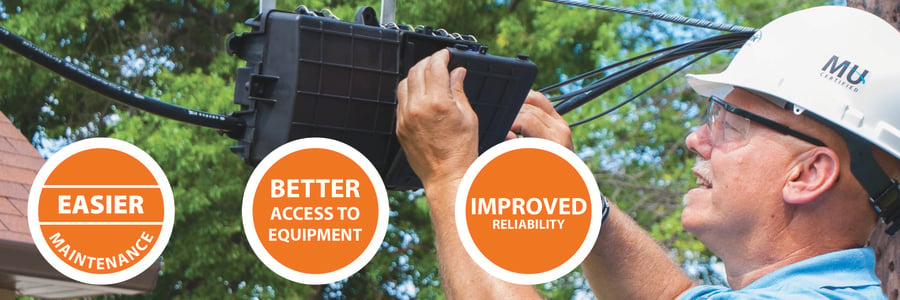{{ quickViewProduct.product_title }}
Stock ID
{{ quickViewProduct.product_stock_number }}
Product Features:
- {{ feature.product_feature_description }}
{{ option.product_option_title }}
{{ value.product_option_value_title }}
 Rural broadband deployments yield many benefits, allowing small businesses to flourish, smaller communities to have access to more resources such as health and education, as well as remote work without traveling to the nearest city. The expansion of broadband accessibility not only benefits isolated communities, it benefits all communities by opening smaller businesses to global markets they otherwise would have been blocked off from. Much like other infrastructure networks throughout the country, broadband shrinks the gap between the urban and rural communities fueling commerce, innovation, and the economy.
Rural broadband deployments yield many benefits, allowing small businesses to flourish, smaller communities to have access to more resources such as health and education, as well as remote work without traveling to the nearest city. The expansion of broadband accessibility not only benefits isolated communities, it benefits all communities by opening smaller businesses to global markets they otherwise would have been blocked off from. Much like other infrastructure networks throughout the country, broadband shrinks the gap between the urban and rural communities fueling commerce, innovation, and the economy.
The planning process of a fiber network provides upper management with the information they need to navigate the challenges ahead. Ultimately, preparedness enables management to make effective decisions and allocate resources to achieve a reliable and cost-effective broadband infrastructure. Often, the planning process involves:
|

Building a broadband network right the first time not only speeds up the process, but it also ensures that every part of the process is done correctly. Cutting corners inevitably results in increased operating expenses and restoration work causing customer dissatisfaction. With a smaller subscriber take-rate, rural networks inevitably cost more per connection, adding emphasis on the importance of being thorough with every stage of the build.
Once the planning stages and network architecture type has been decided, select a vendor that offers quality products, quality service, and support throughout the life of the products. You are not just looking for a vendor, you are looking for a partner.
Partnering with a manufacturer of non-proprietary equipment will aid in maintaining competitive pricing while adding flexibility to your network. The equipment used to construct a fiber network is already specialized, so it should not become more difficult for your technicians to find the right parts. Contrarily, the use of proprietary systems developed by telecommunications manufacturers limit technicians to specific services and fewer equipment options. In addition, the manufacturer has the freedom to raise pricing. The three foremost benefits to using non-propriety equipment are:
|

Once the network infrastructure is in place, it is crucial to ensure that the network is properly maintained. At a minimum, a quarterly maintenance schedule will reduce the number of unexpected complications. Although routine maintenance is recommended for fiber networks, it is imperative to prioritize what types of maintenance needs are essential. Many components within a fiber network are susceptible to failure if they are mishandled. Employee training promotes efficiency and overall reliability. If your subscribers do not have any issues and are satisfied with your service, they will become loyal to your business. Maintaining your equipment means maintaining your customers.
Training your technicians is a major part of maintaining your network. To ensure that the network is properly maintained, network restoration time is low, and troubleshooting is effective, your technicians and/or contractors must be properly trained and held to a standard of work. Often, vendors will train installers on how to properly use their products. This makes some vendors more valuable than others.
Products to Explore:
Fiber Tap Plus - designed for fiber builds where a hardened connector is the preferred method of drop deployment.
Optima Series - makes field installations easier and economically feasible by eliminating the use of hardened connectors in favor of standard SC and LC connectors. The Optima™ S features separate splicing and drop compartments, allowing for installs without disturbing the splicing partition.
Opti-Drop™ Drop Cable - Designed to pair perfectly with Multilink’s Optima™ Closures, our OptiDrop™ fiber can be ordered pre-terminated in different combinations of length and connector types, so you can customize the perfect assembly for your network.
Starfighter™ Dome Enclosures - This closure series features a gasketed split-end plate for mid-access cable applications and an easy to install “no special tool” sealing system.
Starfighter™ In-Line Splice Enclosures - This fiber optic splice enclosure series is designed for splicing applications in both above and below-grade installations.
RNI Enclosures - Setting the standard in demarcation enclosures, our RNI enclosures offer different options including the patented Flexgrid™ system, slack brackets, and captive and non-captive entrances.
SpeedFlex™ - This strong but flexible fiber cable designed to be installed in rigid and flexible conduit which can be stapled directly to the wall.
Mechanical Connectors - Outstanding loss ratings combined with lightning speed installation times, our mechanical field-installable connectors have been field-tested for reliability and longevity.
H IP Field Installable Connectors - The H IP Field Installable can be utilized with flat, round, ROC®, and SpeedFlex™ drop fibers.
Back to MultilogFor more information on how Multilink can help you establish maintenance routines, train your technicians, or aid in the planning of your rural broadband network contact our team at 440-366-6966.